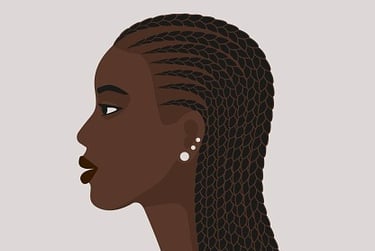Embracing Natural Hair Care Routines for Children on the Spectrum: Tips and Techniques for Parents
Ultimately, prioritizing hair health through consistent trimming and maintenance cannot be overstated. By adopting these practices, parents will help lay the foundation for beautiful, healthy hair that can withstand the rigors of childhood play and activity. Such attention to detail emphasizes the importance of establishing a comprehensive hair care routine that parents and children can enjoy together.
AUSTISM SUPPORT
W. Love
3/23/20257 min read


Establishing a consistent hair care routine holds significant benefits for children, particularly for those with autism. We tried to fight hard against routines, but when we saw the difference in behavior, we knew we needed to make a family change. Predictability is a core component in providing comfort and well-being for children on the autism spectrum. A structured routine can eliminate anxiety and stress that may arise from unexpected activities. Unfortunately, as a military family, we often has disruptions, so recovering has been part of our journey. (That's for another blog)
For now, let's talk about hair. By incorporating a familiar hair care regimen, parents can create a safe space and promote positive associations with grooming. Eventually, they will give you insight about their preferences and ideas as long as you have an open space for trial and error. A lot of trial and error.
The components of a routine can include washing, styling, and maintenance. For washing, parents might select a specific day of the week, using gentle, natural products that are suitable for their child’s hair type. The consistency of using the same products helps in developing a sense of familiarity. Keep in mind, everything is sensory input all senses are activated, pay attention to any cues. Furthermore, children can benefit from participating in the decision-making process by choosing their hair care items, smelling is huge, try familiar peppermint or fruity scents, which can increase their comfort and willingness to engage during grooming sessions.
Styling, too, can be tailored to meet individual preferences and needs. Parents might consider simple styles that require minimal manipulation, ensuring they are quick and easy to perform. By involving children in choosing their daily styles, parents can foster independence and confidence in managing their hair. Additionally, demonstrations and practice can help children become accustomed to the styling process, making it less daunting. We have a doll head where we can mimic hair styles or even have her 'doing' hair at the same time.
Maintenance, often overlooked, is equally important. Moisture, moisture, moisture for our 4c textures. Regular brushings, trims, or even detangling sessions can be incorporated into a bi-weekly routine, preferably at a consistent time. Such practices not only maintain the health of the hair but help solidify the grooming habit. Overall, by adhering to a predictable hair care routine, you can ease your child's discomfort and enhancing their overall hair care experience.
Exploring New Techniques and Tools for Hair Care
When it comes to caring for children’s hair, embracing innovative techniques and tools can significantly enhance the experience for both parents and children. For many families, the process of washing, detangling, and styling can become a stressful routine. However, introducing new methods can make hair care a much more enjoyable and efficient process. One of the first steps is to understand that every child’s hair is unique, and approaches should be tailored accordingly.
Another tip is to set the scene. Are there any comfort items or compression gear that can help keep your child regulated?
Incorporating gentle detangling techniques can help minimize discomfort during hair care. For example, using a wide-tooth comb or a detangling brush designed specifically for children can reduce breakage and pain while combing through knots. Many parents find that applying a leave-in conditioner, pre shampoo, or a detangling spray before combing helps to soften the hair, making it easier to manage. It's essential to work from the tips towards the roots, which can alleviate the tightness of knots and create a smoother experience.
Additionally, the experience of washing hair can be transformed by employing playful techniques. For instance, allowing children to choose a favorite shampoo or conditioner can instill excitement during bathing. Using a soft, angled showerhead or a rinsing cup can make it easier to manage water flow, reducing the chances of splash surprises that might lead to discomfort. It is also worth experimenting with various washing techniques such as the 'upside-down' method, where the child leans forward to help prevent water from running down their face. I have had my children reach down and wash their toes while I quickly rinse hair.
Moreover, the introduction of fun styling tools can make hair styling a creative activity rather than a chore. Accessories like hair beads, colorful elastics, or fun clips can encourage children to participate actively in styling. The key takeaway is that there is no one-size-fits-all solution; discovering what techniques and tools resonate best with your child can turn hair care into a bonding experience.
Understanding Your Child's Hair Type
Understanding your child's hair type is crucial in forming an effective natural hair care routine. Children's hair can come in various types and textures, which can significantly influence the choice of hair products and care techniques. Identifying whether your child's hair is straight, wavy, curly, or coily helps in selecting the right approach to nurture and protect their natural hair.
The first step in recognizing your child's hair type involves examining its texture and curl pattern. Each type possesses unique characteristics, reacting differently to various products and treatments. Which is huge during the process, some products only work for certain seasons, while other products work better depending on your region. I've have noticed that we have had to shift hair products from each move across the country.
Another aspect to consider is the porosity of your child's hair, which indicates how well it absorbs moisture. High porosity hair tends to soak up products quickly, while low porosity hair resists moisture and requires specific care methods to properly hydrate. This understanding will aid parents in selecting moisturizers and conditioners tailored to their child’s needs.
After determining the hair type and porosity, parents should opt for products that enhance and preserve the hair's natural texture. For instance, light leave-in conditioners work well for wavy hair, while heavier creams may be more suitable for coily textures.
Furthermore, natural oils, such as coconut or jojoba oil, can help seal moisture and add softness. Proper knowledge of your child's hair type and characteristics not only ensures effective care but also promotes self-acceptance and appreciation of their natural beauty.
When Cutting Hair is the Best Option
Choosing to cut a child’s hair can sometimes feel daunting for parents, but it may be the most practical solution for maintaining healthy hair in certain situations. Hair cutting can be beneficial for several reasons, particularly when considering ease of management and the overall comfort of the child. For instance, if a child has hair that is difficult to detangle, cutting it can considerably reduce the time spent on daily grooming routines, leading to a more positive experience for both parent and child.
Additionally, children may experience discomfort from tangled or overly long hair. In instances where knots become a frequent occurrence, or when overheating becomes an issue during hot weather, a haircut can provide immediate relief. Furthermore, shorter hairstyles can often be more manageable for active children who regularly engage in physical activities. This ease of daily care enhances the child's comfort and can protect the health of their hair by decreasing instances of breakage associated with knots and tangles. Making wash days easier, quicker and tear free.
Involving children in the decision-making process, such as letting them choose a new style or design, can help foster a sense of ownership and acceptance of the change. By framing the haircut as an exciting adventure rather than a loss, parents can minimize anxiety and ensure a smoother experience.
Exploring Short Hairstyles for Girls
When considering short hairstyles for girls, parents can choose from a variety of options that blend fashion with functionality, which is crazy because so many people are willing to buzz cut a boy. However, short haircuts not only provide ease of maintenance but also provide confidence of a new look with styling options.
An equally popular alternative is the pixie cut, which can also be an afro for natural hair. This option is particularly advantageous for young girls with thick or curly hair, as it simplifies their hair care routine while highlighting their features. The pixie cut can be customized with longer bangs or textured layers, providing an opportunity to introduce elements of fun and flair. Such styles work beautifully for various hair textures, ensuring that each child’s unique look shines through.
In addition to these cuts, it’s fun to consider how accessories can enhance these hairstyles. Hair clips, headbands, and colorful barrettes can add a personal touch to short hairstyles, transforming a simple cut into an expression of individuality. Furthermore, mothers may explore braid accents or twists as quick styling methods that can also keep hair neat and secure throughout the day.
Ultimately, embracing short hairstyles for girls is not merely about aesthetics; it embodies practicality and ease of upkeep. Parents have the opportunity to choose hairstyles that reflect their child's personality while also accommodating a busy, carefree lifestyle. As each child is unique, selecting the appropriate style that aligns with their preferences and hair type remains key, fostering a love for natural hair care from an early age.
If they hate it, then braid it lol. I will say that I learned to braid because of this.
The Role of Healthy Hair: Trimming and Maintenance
Healthy hair is essential, not only for aesthetic reasons but also for their comfort and overall well-being. Regular trims and maintenance play a significant role in preserving hair health. This proactive approach helps prevent damage such as split ends and breakage, enabling hair to grow more robustly. Indeed, a well-maintained hairstyle can significantly enhance a child's confidence and self-esteem.
Trimming hair regularly is particularly important for children with curly or textured hair, as these hair types are more prone to dryness and damage. For such hair types, it is advisable to schedule trims every 6 to 8 weeks to manage any potential breakage effectively.
In addition to improving the appearance of hair, regular maintenance also allows parents to properly assess the overall health of their child’s hair. This assessment can involve checking for signs of dryness, breakage, or scalp issues that may require attention. We started oil treatments when we take down braids to help with scalp health. Incorporating gentle hair washing and conditioning routines, along with the appropriate use of hair care products, will further promote a healthy environment for hair growth.
It is essential to choose products that are specifically formulated for children to avoid harsh chemicals that may irritate their sensitive scalps. Texturizers and relaxers are tempting, but with a bit of patience I can assure you can handle hair maintenance.
Hopefully the social media-driven shift in beauty standards, giving rise to the normalization of diverse hair textures and styles. Platforms dedicated to children’s hair care will continue to inspire families with tutorials, styling tips, and product recommendations. As such, parents will be encouraged to embrace their children’s natural hair journeys, fostering confidence and self-acceptance from an early age.
I am officially an family hair stylist, regularly exploring new products and methods, paired with an understanding of my child's specific hair care needs, I ensure that they receive the best support possible. While saving money. Cuz who is paying 120-150$ for children's braids every 2 months, I have 3 girls smh.


